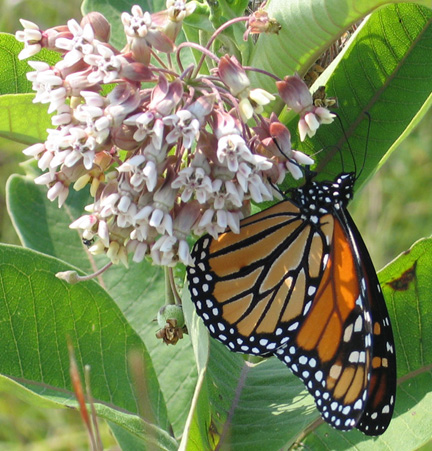
Monarch Butterfly Migration Over Central
Iowa
Fall 2006
By Robert D. Woodward

A monarch stops on a milkweed in late August.
August 30--Sixty-seven monarch butterflies were noted at Neal Smith National Wildlife Refuge during a visit of one and one-half hours in the morning. Many were spotted on the northern edge of the refuge, suggesting they were part of the early movement of monarchs beginning their migration to the south. They often were seen coming up out of the big bluestem grasses where they likely were staying overnight. Field observations at the refuge during the summer months did not reflect as much monarch activity in this northern area.
September 1--Monarch activity at Neal Smith National Wildlife Refuge continued to increase as 155 monarchs were observed in a bit more than two hours. The most popular nectaring flowers were tickseed sunflowers and common thistles. Numerous monarchs were found in a large stand of tickseeds where the butterflies were flying to and fro as they moved from flower to flower. Often two or more monarchs were chasing each other in the air above.
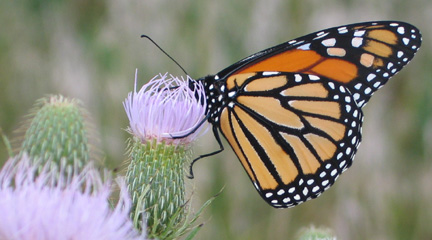
Thistles are attracting the migrating monarchs.
September 2--The numbers of monarchs observed seemed to confirm the early phase of the monarch migration has begun over central Iowa. Monarchs could be observed flying into the refuge from the north, and the butterflly activity continued to grow at the refuge. In two and one-half hours, 195 monarchs were counted. Once again the tickseed sunflowers and common thistles were the favored wildflowers for nectaring. The goldenrod is in full bloom but has yet to be attracting the monarchs as it has in other years. An occasional monarch could be seen stopping on an ox-eyed sunflower or cup plant.
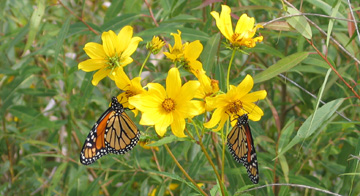
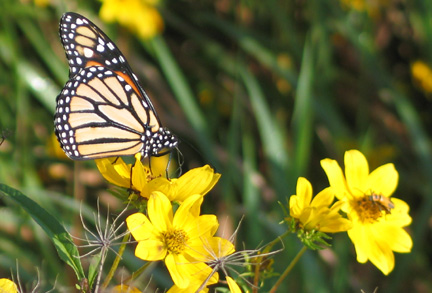
Tickseed sunflowers are a favorite for the monarchs.
September 3--Rainfall late Saturday afternoon dampened the prairie grasses at Neal Smith National Wildlife Refuge, slowing the monarch activity on Sunday morning. In the first hour Sunday, two monarchs were observed, one of which was drying its wings atop a sawtooth sunflower. As the sun came out and began to dry up the prairie, the monarchs began moving again. Sixty-one monarchs were counted in the next hour. Among the monarchs nectaring on tickseeds was a viceroy butterfly.
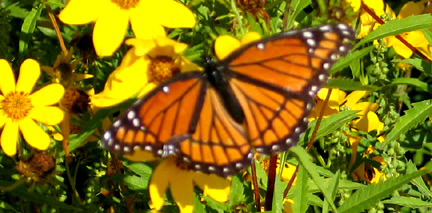
A viceroy butterfly wants a share of the tickseed nectar.
September 4--Monarch butterflies were continuing to seek out the tickseed sunflowers for their nectaring. During a one and one-half hour visit in the afternoon, 146 monarchs were counted--most of which were gathering in a large stand of tickseeds.
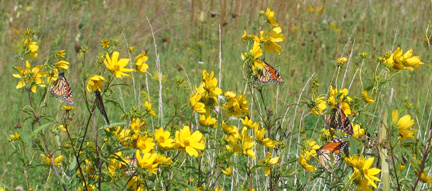
The monarchs were flocking to tickseeds.
September 5--During an afternoon visit to Neal Smith National Wildlife Refuge, an interesting change was occurring in the monarchs' nectaring pattern. For the first time this fall, numbers of the monarchs were seeking out goldenrod flowers for their nectaring. Others were continuing to stop on the tickseed sunflowers and an occasional thistle. The count during a visit of an hour and 45 minutes was 154 monarchs.
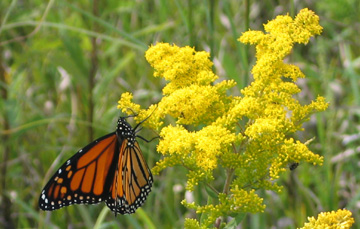
Nectaring time on the goldenrod
September 6--Monarchs were on the move this morning at Neal Smith National Wildlife Refuge. In two hours of observation, 238 monarchs were counted. They were nectaring on tickseeds, thistles, and goldenrod. This is the largest number observed this fall, indicating the next week likely will be even more active with migrating monarchs.
September 7--A strong wind from the southwest slowed the monarch movement at Neal Smith National Wildlife Refuge. During a late afternoon visit of about one hour, 67 monarchs were counted.
September 8--For a second straight day, the wind was blowing from the southwest at Neal Smith refuge. In two and one-quarter hours, 136 monarchs were observed. They were continuing to center their nectaring activities on tickseeds, thistles, and goldenrod.
September 9--The first "Monarch Madness" program was held Saturday at Neal Smith National Wildlife Refuge. Park staff members worked with participating children and adults in tagging 51 monarch butterflies under a program supported by the University of Kansas Monarch Watch. The morning was cloudy, damp, and foggy at the start, but by the time the prospective taggers took to the field in late morning, they stirred up plenty of monarchs in the habitat near the prairie center and along the refuge's savanna trail. Another 111 monarchs were observed indepedently during the morning, including 85 over the noon hour in the north part of the refuge. As the day warmed up and cleared off somewhat, the monarchs seemed to be migrating into the refuge from the north.
September 10--Rainfall across the state throughout the day limited the possibility of migration by the monarch butterflies. Monarchs don't fly in the rain for any extended time, although I have seen them flying high in the cloudy sky over the years racing ahead of an impending rainstorm. If the monarchs' wings get wet, they find a roost on the ground where they can dry out.
September 11--Rain and dampness continued to slow the monarch butterfly migration.
September 12--Another day of damp and cool weather was slowing the monarchs. A single monarch was spotted flying across a roadway.
September 13--In the wake of three days of rain, dampness, and cool weather, today was sunny and mild, and the monarch butterflies were on the move once again. During a morning and an afternoon visit to Neal Smith National Wildlife Refuge, 643 monarchs were counted, the largest number to date this autumn. In both visits, a large stand of sawtooth sunflowers in the northern part of the refuge was the main attraction for nectaring monarchs. In a flurry of activity in late afternoon, 266 monarchs were observed in 35 minutes as they flew here and there among the large stand of sunflowers--some of which now reach 8 to 10 feet.
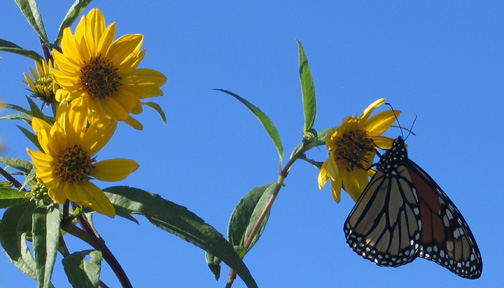
On a beautiful autumn day, a monarch finds a sawtooth sunflower.
September 14--More than 100 monarchs were counted crossing the highways during a 160-mile trip from Altoona, Iowa, to Fort Madison, Iowa, during the afternoon. Along the Mississippi River in Fort Madison, numerous monarchs could be seen flying south along the river in the late afternoon.
September 16-17--Friends reported seeing numerous monarchs in the Des Moines area over the weekend. One family counted 100 monarchs during a drive from central Des Moines to the west side.
September 18--Strong winds from the south southwest hampered the possibility of any monarch movement over Neal Smith National Wildlife Refuge. During a two-hour visit to the refuge, only two monarchs were observed struggling against the wind in the north part of the preserve. A two-mile walk along the refuge's Tallgrass Prairie Trail turned up little butterfly activity on the chilly day.
September 19--Temperatures in the low 40s in the early morning set the tone for the day in central Iowa. No monarchs were observed, and even lower temperatures were predicted overnight for the counties to the north. A frost advisory was issued for those areas.
September 20--Just when it appeared their migration activity over central Iowa was about to end, the monarch butterflies put on a spectacular show at Neal Smith National Wildlife Refuge. In a bit more than three hours of observation, 432 monarchs were counted as they moved to and fro over sawtooth sunflowers, nectared on native New England purple asters, and stopped on an occasional thistle. The appearance of so many monarchs indicated their capability to survive the rainy days and cold weather that has hit central Iowa in recent days. This morning, counties to the north reported temperatures in the mid-30 degrees, and central Iowa started the day in the low 40s. Many of the monarchs at Neal Smith appeared to have been hiding in the safety of the tall big bluestem grasses. As the day warmed up around the noon hour, the monarchs came up out of the grasses and were on the move. Two days ago, only two monarchs were seen in more than two hours.
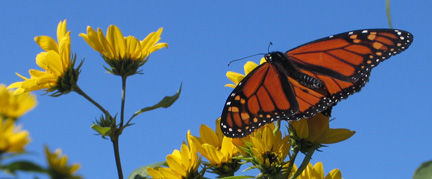
Monarchs were active over the sawtooth sunflowers.
September 21--Once again, cool and rainy weather slowed the monarch movement. On the previous day, in addition to the heavy activity at Neal Smith National Wildlife Refuge, migrating monarchs were coming into our butterfly garden in Altoona, Iowa. They especially were enjoying the nectar of the native New England purple asters. In Des Moines, friends reported substantial monarch activity across the area on September 20.
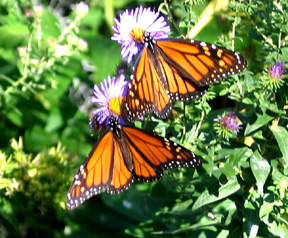
Two monarchs enjoy the New England purple asters.
September 22--Given the inconsistent rains and colder weather in the last week, I went searching at Neal Smith National Wildlife Refuge for migrating monarchs that might have been slowed on their trip south. In the north of the refuge, I counted 16 monarchs in an area where most of them were clinging to tall sawtooth sunflowers as the plants waved in a strong wind. To the south about three miles, I went walking along a savanna trail that sits at the edge of the prairie and a wooded area of oaks, hickories, and other trees. There on a hillside in an area protected from the strong wind, I enjoyed a "monarch moment" as the butterflies dipped out of the trees onto various wildflowers for nectaring. In the next two hours, I counted more than 200 monarchs in the quiet surroundings. Overall, the count for the day was 251 monarchs.
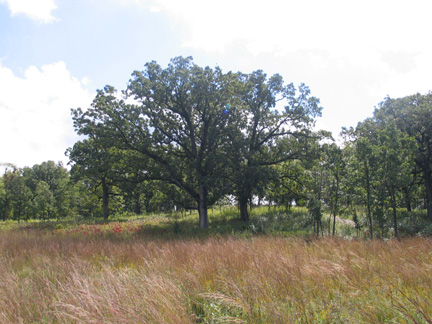
Where the prairie meets the oak trees is where the monarchs stayed.
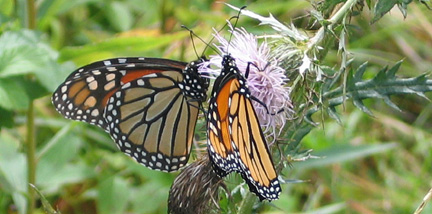
A twosome enjoys a thistle in the quietude of the woods.
September 23--On this Saturday, the monarch migration continued over central Iowa at Neal Smith National Wildlife Refuge and in the city of Des Moines. At Neal Smith, 150 monarchs were counted in 2 1/2 hours, and family members observed at least 50 more in Des Moines. Monarchs also were seen in our butterfly garden and flying across the highways in the area. Based on my observational records of monarch movements over the years, by the date of September 23, the migration has been virtually completed in the area in four of the five most recent years. It now seems clear this year's migration was slowed by the cold weather and continued rainfall. On Saturday morning, the monarchs came flying into the refuge from the north one at a time, then sought out nectaring areas. The native purple asters were a definite favorite. To the south near the refuge's savanna trail, other monarchs were lingering there in the warmth of a protected area.

New England asters were a major attraction for the monarchs.
September 24--After a flurry of activity on Friday and Saturday, the migration of monarchs slowed considerably on Sunday across central Iowa. The day was cool and sunny with a mild wind from the north northwest, seemingly a good day for monarch migration. But in 2 1/4 hours of observation in the morning, only eight monarchs were noted at Neal Smith National Wildlife Refuge. Family members saw several monarchs in Des Moines. A 30-mile drive in northeast Polk County in the afternoon turned up only a single monarch. Back home in the late afternoon, two monarchs were nectaring on flowers in our butterfly garden.
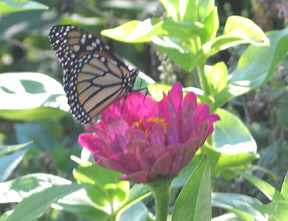
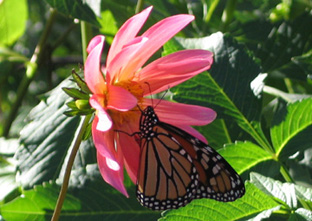
Monarchs enjoyed the zinnias and dahlias in the butterfly garden.
September 25--The day was beautiful with migrating monarch butterflies visiting New England purple asters at Neal Smith National Wildlife Refuge. The morning started slowly with no monarchs sighted in the first hour in the northern part of the refuge, but elsewhere the butterflies were found nectaring on sawtooth sunflowers and especially on the purple asters. In three hours of observations, 71 monarchs were counted. As the temperature warmed into the 60s on a clear day, the monarchs began showing up on several stands of asters in the northern part of the refuge where there had been no migrating butterflies earlier.
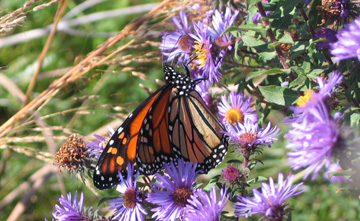
A monarch seeks out the asters on a sunny September day.
September 26--Three monarchs were observed in our butterfly garden in Altoona, Iowa, and several were seen along the roadways.
September 27--The day was cloudy and cool, and a cold front was moving through central Iowa. During a one-hour visit to Neal Smith National Wildlife Refuge, only two monarchs were noted--both in the savanna area where the prairie meets the woods. The monarch migration was coming to an end over central Iowa.
September 28--No monarchs were sighted.